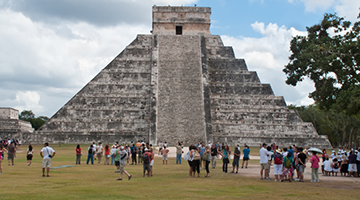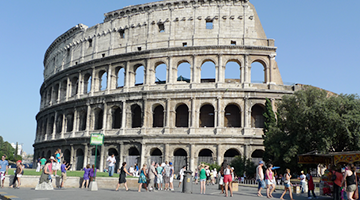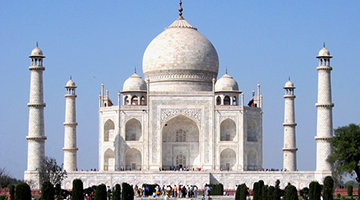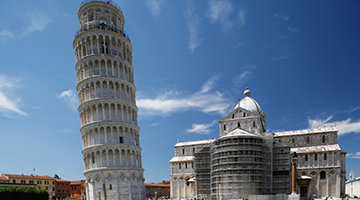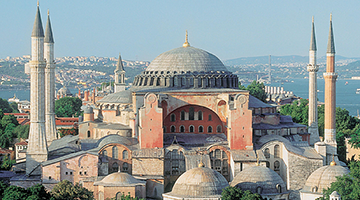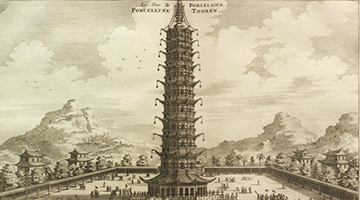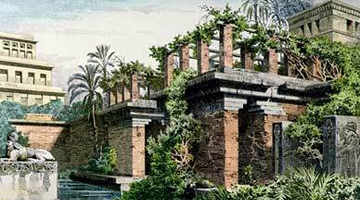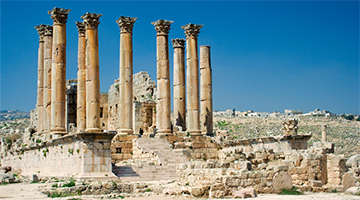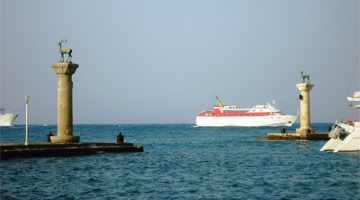Great Wall of China
This newly elected world wonder was built along China's northern border over many centuries to keep out invading Mongol tribes. Constructed between the fifth century B.C. and the 16th century, the Great Wall is the world's longest human-made structure, stretching some 4,000 miles (6,400 kilometers). The best known section was built around 200 B.C. by the first emperor of China, Qin Shi Huang Di.
Petra, Jordan
Perched on the edge of the Arabian Desert, Petra was the capital of the Nabataean kingdom of King Aretas IV (9 B.C. to A.D. 40). Petra is famous for its many stone structures such as a 138-foot-tall (42-meter-tall) temple carved with classical facades into rose-colored rock. The ancient city also included tunnels, water chambers, and an amphitheater, which held 4,000 people. The desert site wasn't known to the West until Swiss explorer Johann Ludwig Burckhardt came across it in 1812.
Christ the Redeemer
The 105-foot-tall (38-meter-tall) 'Christ the Redeemer' statue in Rio de Janeiro, Brazil, was among the "new seven wonders of the world" announced July 7, 2007 following a global poll to decide a new list of human-made marvels. The winners were voted for by Internet and phone, American Idol style. The other six new wonders are the Colosseum in Rome, India's Taj Mahal, the Great Wall of China, Jordan's ancient city of Petra, the Inca ruins of Machu Picchu in Peru, and the ancient Maya city of Chichen Itza in Mexico.
Machu Picchu, Peru
One of three successful candidates from Latin America, Machu Picchu is a 15th-century mountain settlement in the Amazon region of Peru. The ruined city is among the best known remnants of the Inca civilization, which flourished in the Andes region of western South America. The city is thought to have been abandoned following an outbreak of deadly smallpox, a disease introduced in the 1500s by invading Spanish forces.
Chichen Itza, Mexico
Chichen Itza is possibly the most famous temple city of the Mayas, a pre-Columbian civilization that lived in present day Central America. It was the political and religious center of Maya civilization during the period from A.D. 750 to 1200. At the city's heart lies the Temple of Kukulkan (pictured)-which rises to a height of 79 feet (24 meters). Each of its four sides has 91 steps-one step for each day of the year, with the 365th day represented by the platform on the top.
The Colosseum, Rome, Italy
The only finalist from Europe to make it into the top seven—the Colosseum in Rome, Italy-once held up to 50,000 spectators who came to watch gory games involving gladiators, wild animals, and prisoners. Construction began around A.D. 70 under Emperor Vespasian. Modern sports stadiums still resemble the Colosseum's famous design.
Taj Mahal, India
The Taj Mahal, in Agra, India, is the spectacular mausoleum built by Muslim Mughal Emperor Shah Jahan to honor the memory of his beloved late wife, Mumtaz Mahal. Construction began in 1632 and took about 15 years to complete. The opulent, domed mausoleum, which stands in formal walled gardens, is generally regarded as finest example of Mughal art and architecture. It includes four minarets, each more than 13 stories tall. Shah Jahan was deposed and put under house arrest by one of his sons soon after the Taj Mahal's completion. It's said that he spent the rest of his days gazing at the Taj Mahal from a window.
Leaning Tower of Pisa
This is the monument that, among the others of the "Piazza dei Miracoli", stirs the imagination of everybody, from the old to the young. Firstly we like to give you some information and events regarding its long history. The construction of this imposing mass was started in the year 1174 by Bonanno Pisano. When the tower had reached its third storey the works ceased because it had started sinking into the ground. The tower remained thus for 90 years. It was completed by Giovanni di Simone, Tommano Simone (son of Andreo Pisano), crowned the tower with the belfry at half of 14th century. The top of the Leaning Tower can be reached by mounting the 294 steps which rise in the form of a spiral on the inner side of the tower walls.
Hagia Sophia
Unfortunately nothing remains of the original Hagia Sophia, which was built on this site in the fourth century by Constantine the Great. Constantine was the first Christian emperor and the founder of the city of Constantinople, which he called "the New Rome." The Hagia Sophia was one of several great churches he built in important cities throughout his empire. Following the destruction of Constantine's church, a second was built by his son Constantius and the emperor Theodosius the Great. This second church was burned down during the Nika riots of 532, though fragments of it have been excavated and can be seen today. Hagia Sophia was rebuilt in her present form between 532 and 537 under the personal supervision of Emperor Justinian I. It is one of the greatest surviving examples of Byzantine architecture, rich with mosaics and marble pillars and coverings.
Porcelain Tower of Nanjing, China
The Porcelain Tower is in Nanjing, China, out on the banks of the Yangtze River. The Chinese people called it the Boa’ensi or the “Temple of Gratitude”. The base shape is octagonical. The base is about 95 feet in diameter; the tower itself is about 9 stories tall, which is about 250 feet high. When the tower was being built it was planned to be 13 stories tall and a total height of 330 feet. Every block in the tower was dried out in the blazing sun during the day and in the night there was 140 lamps to dry them out. The bricks were made of brilliant white porcelain that would shine in sunlight. As the stories went up it narrowed because if they were all the same size it would collapse on top of everything. A large spire came from the eighth story all the way up to the roof. The spiral staircase went up 130 steps. In 1801 a bolt of lightning struck and knocked of the top three stories. Soon after that the Taiping Rebels gained control of the city and destroyed the Porcelain Tower of Najing.
Great Wall of China
This newly elected world wonder was built along China's northern border over many centuries to keep out invading Mongol tribes. Constructed between the fifth century B.C. and the 16th century, the Great Wall is the world's longest human-made structure, stretching some 4,000 miles (6,400 kilometers). The best known section was built around 200 B.C. by the first emperor of China, Qin Shi Huang Di.
Catacombs of Kom el Shoqafa
The Catacombs (meaning underground tunnels) lie in the district of Karmouz to the east of Alexandria. The area was called Kom El-Shouqafa or a pile of shards. The cemetery dates back to the 1st century A.D and was used until the 4th century A.D. It was discovered in 1900 when by pure chance, a donkey drawn cart fell into a pit, which led to the discovery. The Catacombs in Alexandria are so called because the design was very similar to the Christian Catacombs in Rome. Most likely it was a private tomb, later converted to a public cemetery. It consists of 3 levels cut into the rock, a staircase, a rotunda, the triclinium or banquette hall, a vestibule, an antechamber and the burial chamber with three recesses in it; in each recess there is a sarcophagus. The Catacombs also contain a large number of Luculi or grooves cut in the rock.
The Colosseum, Rome, Italy
The only finalist from Europe to make it into the top seven—the Colosseum in Rome, Italy-once held up to 50,000 spectators who came to watch gory games involving gladiators, wild animals, and prisoners. Construction began around A.D. 70 under Emperor Vespasian. Modern sports stadiums still resemble the Colosseum's famous design.
Stonehenge, United Kingdom
Stonehenge is a megalithic rock monument of 150 enormous stones set in a purposeful circular pattern, located on the Salisbury Plain of southern England, the main portion of it built about 2000 BC. The outside circle of Stonehenge includes 17 enormous upright trimmed stones of hard sandstone called sarsen; some paired with a lintel over the top. This circle is about 30 meters (100 feet) in diameter, and, stands about 5 meters (16 feet) tall. Inside the circle are five more paired-and-linteled stones of sarsen, called trilithons, each of these weighing 50-60 tons and the tallest 7 meters (23 feet) high. Inside that, a few smaller stones of blue stone, quarried 200 kilometers away in the Preseli Mountains of western Wales, are set in two horseshoe patterns. Finally, one large block of Welsh sandstone marks the center of the monument.
The Great Pyramid of Giza, Egypt
The Egyptian pharaoh Khufu built the Great Pyramid in about 2560 B.C. to serve as his tomb. The pyramid is the oldest structure on the original list of the seven wonders of the ancient world, which was compiled by Greek scholars about 2,200 years ago. It is also the only remaining survivor from the original list. The Great Pyramid is the largest of three Pyramids at Giza, bordering modern-day Cairo. Although weathering has caused the structure to stand a few feet shorter today, the pyramid was about 480 feet (145 meters) high when it was first built. It is thought to have been the planet's tallest human-made structure for more than four millennia.
Hanging Gardens of Babylon
The hanging gardens are said to have stood on the banks of the Euphrates River in modern-day Iraq, although there's some doubt as to whether they ever really existed. The Babylonian king Nebuchadnezzar II supposedly created the terraced gardens around 600 B.C. at his royal palace in the Mesopotamian desert. It is said the gardens were made to please the king's wife, who missed the lush greenery of her homeland in the Medes, in what is now northern Iran. Archaeologists have yet to agree on the likely site of the hanging gardens, but findings in the region that could be its remains include the foundations of a palace and a nearby vaulted building with an irrigation well. The most detailed descriptions of the gardens come from Greek historians. There is no mention of them in ancient Babylonian records.
Statue of Zeus at Olympia
The massive gold statue of the king of the Greek gods was built in honor of the original Olympic games, which began in the ancient city of Olympia. The statue, completed by the classical sculptor Phidias around 432 B.C., sat on a jewel-encrusted wooden throne inside a temple overlooking the city. The 40-foot-tall (12-meter-tall) figure held a scepter in one hand and a small statue of the goddess of victory, Nike, in the other—both made from ivory and precious metals. The temple was closed when the Olympics were banned as a pagan practice in A.D. 391, after Christianity became the official religion of the Roman Empire. The statue was eventually destroyed, although historians debate whether it perished with the temple or was moved to Constantinople (now Istanbul) in Turkey and burned in a fire.
The Temple of Artemis, Turkey
The great marble temple dedicated to the Greek goddess Artemis was completed around 550 B.C. at Ephesus, near the modern-day town of Selçuk in Turkey. In addition to its 120 columns, each standing 60 feet (20 meters) high, the temple was said to have held many exquisite artworks, including bronze statues of the Amazons, a mythical race of female warriors. A man named Herostratus reportedly burned down the temple in 356 B.C. in an attempt to immortalize his name. After being restored, the temple was destroyed by the Goths in A.D. 262 and again by the Christians in A.D. 401 on the orders of Saint John Chrysostom, then archbishop of Constantinople (Istanbul).
The Mausoleum of Halicarnassus, Turkey
The famous tomb at Halicarnassus-now the city of Bodrum-was built between 370 and 350 B.C. for King Mausolus of Caria, a region in the southwest of modern Turkey. Legend says that the king's grieving wife Artemisia II had the tomb constructed as a memorial to their love. Mausolus was a satrap, or governor, in the Persian Empire, and his fabled tomb is the source of the word "mausoleum." The structure measured 120 feet (40 meters) long and 140 feet (45 meters) tall. The tomb was most admired for its architectural beauty and splendor. The central burial chamber was decorated in gold, while the exterior was adorned with ornate stone friezes and sculptures created by four Greek artists. The mausoleum stood intact until the early 15th century, when Christian Crusaders dismantled it for building material for a new castle. Some of the sculptures and frieze sections survived and can be seen today at the British Museum in London, England.
The Colossus of Rhodes, Greece
In contrast to the pyramids, the colossus was the shortest lived of the seven wonders of the ancient world. Completed in 282 B.C. after taking 12 years to build, the Colossus of Rhodes was felled by an earthquake that snapped the statue off at the knees a mere 56 years later. The towering figure-made of stone and iron with an outer skin of bronze—represented the Greek sun god Helios, the island's patron god. It looked out from Mandraki Harbor on the Mediterranean island of Rodos (Rhodes), although it is no longer believed to have straddled the harbor entrance as often shown in illustrations. The Colossus stood about 110 feet (33 meters) tall, making it the tallest known statue of the ancient world. It was erected to celebrate the unification of the island's three city-states, which successfully resisted a long siege by the Antigonids of Macedonia.
The Lighthouse of Alexandra
The lighthouse was the only ancient wonder that had a practical use, serving as a beacon for ships in the dangerous waters off the Egyptian port city of Alexandria, now called El Iskandariya. Constructed on the small island of Pharos between 285 and 247 B.C., the building was the world's tallest for many centuries. Its estimated height was 384 feet (117 meters) -equivalent to a modern 40-story building-though some people believe it was significantly taller. The lighthouse was operated using fire at night and polished bronze mirrors that reflected the sun during the day. It's said the light could be seen for more than 35 miles (50 kilometers) out to sea. The huge structure towered over the Mediterranean coast for more than 1,500 years before being seriously damaged by earthquakes in A.D. 1303 and 1323.
Career Scope in Interior Design
Interior design is a fun and creative field. It mixes art and practicality to make spaces look good and work well. With more people wanting great places to live and work, the need for skilled interior designers is rising. Let’s look at what it takes to have a career in interior design, including nee →
Commonwealth of Independent States (CIS)
Foundation Date: December 8, 1991 Headquarters: The Republic of Belarus Executive Secretaries: Sergei Lebedev Member Countries: 12 Commonwealth of Independent States (CIS) was established on December 8, 1991, and the leaders of the Republic of Belarus, the Russian Federation, and Ukraine signed an a →
What is Bitcoin?
In 2009, an unknown programmer by the name of Satoshi Nakamoto put forward a whitepaper that proposed a creation of new form of digital currency - cryptocurrency. Cryptocurrency functions the same way as regular currencies do in that its used as a means of exchange, unit of account and a store of va →
Food Safety and Standards Authority of India (FSSAI)
Headquarter: New Delhi Function and Objective of the Organization: The Food Safety and Standards Authority of India (FSSAI)has been established under Food Safety and Standards Act, 2006 which consolidates various acts & orders that have hitherto handled food-related issues in various Ministries →
Contribute to our Site
If you contribute your content to our site. Please mail us your content to editor@onlinegk.net




